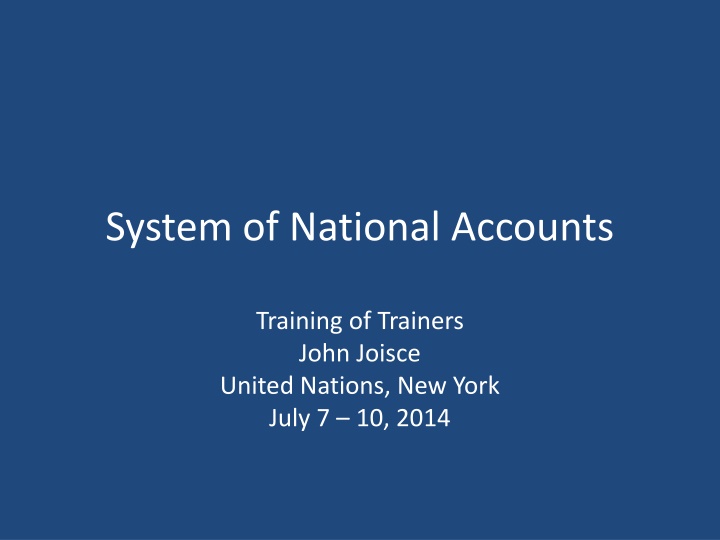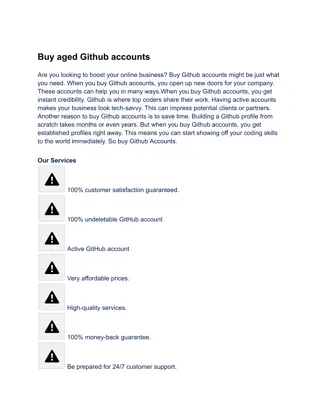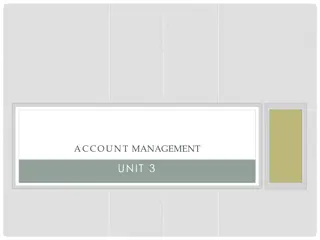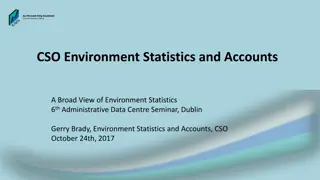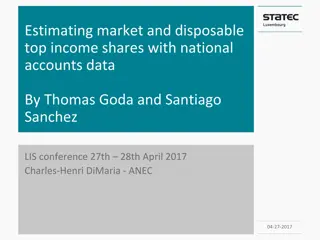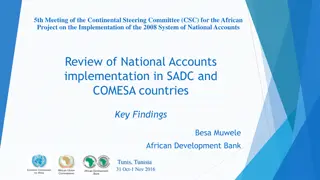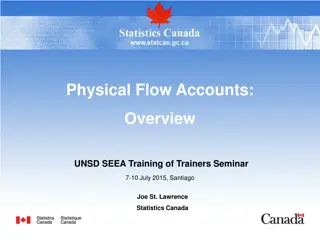Evolution of National Accounts Framework
The System of National Accounts (SNA) has evolved significantly from its origins in the 17th century to the present day, with key developments in response to economic challenges and policy needs. The shift from GDP to a comprehensive set of accounts in 2008 reflects a focus on market-oriented activities and valuations. The importance of residence and institutional units in economic analysis is emphasized, while comparisons with business accounting highlight the differences in objective and scope. Explore the economic underpinnings, policy orientation, and practical applications of the SNA framework.
Download Presentation

Please find below an Image/Link to download the presentation.
The content on the website is provided AS IS for your information and personal use only. It may not be sold, licensed, or shared on other websites without obtaining consent from the author.If you encounter any issues during the download, it is possible that the publisher has removed the file from their server.
You are allowed to download the files provided on this website for personal or commercial use, subject to the condition that they are used lawfully. All files are the property of their respective owners.
The content on the website is provided AS IS for your information and personal use only. It may not be sold, licensed, or shared on other websites without obtaining consent from the author.
E N D
Presentation Transcript
System of National Accounts Training of Trainers John Joisce United Nations, New York July 7 10, 2014
Background Origins date back to 17thcentury: focus was on ability of governments to wage war 20thcentury: 1930s depression and WW2 Keynes, Kuznets, Stone et al 1953 SNA: rudimentary by present standards 1968 SNA (GDP, not GNP) Focus on flows: volume measures, production, consumption, savings and investment 1993 SNA: complete set of accounts, covering balance sheets (including NPNF Assets) 2008 SNA: update of 1993 SNA
Economic underpinnings Between 1953 SNA and 2008 SNA much changed but one thing remained more or less constant: production boundary Focus on market and market-oriented activity Valuations: market prices Not welfare measure (though often used as one) (Most) activity within household for own consumption excluded
Economic underpinnings SNA policy oriented from beginning : 1930s Depression: governments largely ineffectual and operating in a vacuum: belief system would rectify itself (market always in equilibrium) No framework for analysis Need to measure what can be affected by policy and build models from data within theoretical framework (interest rates, fiscal measures (increase in gov t spending, increase in taxes, devaluation, etc.)
Residence and institutional units Residence essential building block for inclusion in national accounts of any given economy Institutional unit: Must be resident in only one economy For twelve months or intention to be resident for twelve months Corporations resident where registered or legal domicile (branches) Able to acquire assets, incur liabilities in own right
Comparison with Business Accounting Business account: Income and expenditure statement Statement of retained earnings Capital accumulation account Cash flow statement (Statement of Changes in Financial Position) Balance sheets Focus on impact on shareholders wealth, how funds have been employed and whether utilized effectively and as efficiently
Sequencing of accounts in SNA Production Account Generation of Income Account Allocation of Primary Income Account Secondary Distribution of Income Account Use of Income Account Capital Account Financial Account Other Changes in Assets Account Balance Sheet
Sequencing of accounts in SNA (cont) Each with balancing item of analytical value All by sector General Government, Nonfinancial Corporations, Financial Corporations, Households, Non-Profit Institutions Serving Households, Rest of World
Production Account An activity, carried out under the responsibility, control and management of an institutional unit, that uses inputs or labour, capital, and goods and services to produce output of goods and services. Balancing item(s): Gross Output less Intermediate Consumption equals Gross Value Added less COFC equals Net Value Added (GOS less) for economy (GDP) and by industry
Supply and Use Tables Further articulation of Production Account Provides commodity balances (supply = use) Provides very detailed commodity data that go into production of goods and services by industry E.g., Australia has 1000 commodities/80 industries Use table also provides final expenditure (consumption and capital formation) Balancing item: Value Added (by industry and for economy as whole) SUT basis for Input/Output analysis (e.g., for measurement of productivity)
GDP at market prices Can be calculated three ways: Final expenditure approach Income approach (Generation of Income: see next slide) Production approach (gross output less intermediate inputs) All conceptually equal
Generation of Income Account Elaboration on production account Represents return to factors of production: labor (compensation of employees: all costs of labor, not just wages) and capital (produced capital and environment (land, subsoil assets, forests, etc.) plus taxes on production less subsidies. Returns to ownership of property (such as financial assets (interest, dividends) and environment (rent) included with returns to capital (these returns captured in Balancing item: GDP (GVA) or NDP (NVA)
Allocation of Primary Income Account Focus on institutional units/sectors as recipients of primary incomes Shows where items payable in generation of income account are receivable but also shows property income (interest, dividends, rent, etc.) payable and receivable Includes property income payable/receivable from abroad so balancing item: Gross (Net) Balance of Primary Income and National Income (used to be called GNP)
Secondary Distribution of Income Account Apart from balance of primary income and balancing item in this account, all other items transfers that is, a transaction for which there is no quid pro quo (such as income taxes, social contributions, social benefits, fines), including transfers with nonresidents Balancing item: Gross/Net (National) Disposable Income
Use of Income Account Purpose to show how households, general government, and NPISHs allocate disposable income between (final) consumption and saving Balancing item: Gross (Net) Saving (Current External Balance Current Account of BOP) Saving adjusted to reflect net change in pension entitlements. No adjustment for depletion or degradation
Capital Account First of 4 accounts dealing with changes in value of assets held by institutional units Records transactions in nonfinancial assets (also includes capital transfers) Focus of account on acquisition/disposal and use (COFC) of produced assets: fixed and inventories Also records net acquisition of nonproduced nonfinancial assets Balancing item: Net Borrowing/Lending
Financial Account Measures transactions in financial assets and liabilities, by type of instrument (deposits, loans, debt securities, shares and other equity, etc.) Focus on financial corporations (intermediaries) and financial instruments Balancing item Net lending/borrowing
Financial Account Source of funds = Use of funds Saving + Net Incurrence of liabilities = GFCF + Net change in Inventories + Net acquisition of NPNFA + net acquisition of financial assets Saving GFCF Net Change in Inventories - Net acquisition of NPNFA = NL/B Net acquisition of financial assets net incurrence of liabilities = NL/B. Therefore, Saving GFCF Net Change in Inventories - Net acquisition of NPNFA = Net acquisition of financial assets net incurrence of liabilities = NL/B
Other Changes in Assets Account Sometimes referred to as other flows : accounts for all changes between opening and closing balance sheets that are not accounted for by transactions Comprise Changes in volume Revaluations
Other Changes in Volume of Assets Account Economic Appearance of (NPNF) Assets: Discoveries, Upward Reappraisals, Growth (of natural forests, fish stock, etc.), Change of land usage (e.g., from outside the production boundary to within, from agricultural to residential). NB: Land improvements = GFCF Economic Disappearance of NPNFA: Reverse of above: Depletion/Abstraction (should be recorded gross of growth but may have to be net); downward reappraisals, change in economic use of land, etc. Catastrophic Losses: earthquakes, hurricanes, fires, drought, spills, etc. Balancing item: Changes in net worth due to other changes in volume
Other Changes in Assets Account Revaluations Covers changes in value of assets due to changes in price/exchange rate in nominal terms Can be broken down between real and neutral gains/losses Balancing item: Changes in net worth due to nominal holding gains/losses
Balance sheet Opening and closing set of assets and liabilities Assets cover produced and nonproduced nonfinancial assets and financial assets Liabilities cover all debt instruments and equity Balancing item: Net worth All preceding accounts account for changes in net worth between opening and closing balance sheets Brings us back to business acounting
SNA and SEEA Where are environmental assets captured in SNA? What changes/adjustments necessary for link with SEEA?
